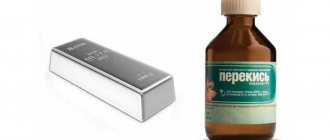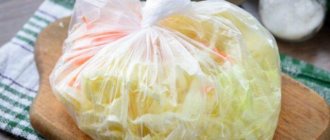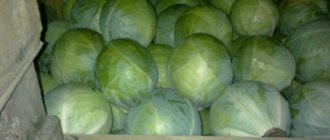Cauliflower is a seasonal vegetable that contains many beneficial substances. Freezing will help you have this product on your table all year round.
But for this you need to know how to freeze cauliflower for the winter (raw, boiled, together with broccoli) correctly, how and how much to store in the freezer, whether it can be defrosted and re-frozen.
The benefits and harms of frozen vegetables
Cauliflower, whether fresh or properly frozen, has a huge amount of vitamins, minerals and microelements and, just as important, retains all its beneficial properties during any type of processing, positively influencing the human body, saturating it with everything necessary.
The correct type of freezing is the so-called “shock” freezing, in which the products do not lose their properties, so when choosing frozen cauliflower, it is important to pay attention to the presence of the corresponding sign on the packaging.
Frozen cauliflower contains the following vitamin and mineral elements:
- vitamins of three groups at once: A, B, C;
- iron;
- magnesium;
- calcium;
- fluorine.
Thus, including cauliflower and dishes made from this vegetable in your menu, a person improves immunity, bone and teeth health. Eliminates the lack of vitamins, especially vitamin C, and helps the intestines get rid of waste and toxins.
This product should be used with caution in cases of enterocolitis and intestinal irritation, gout, problems with the thyroid gland, after recent surgery, allergies or individual intolerance to this product.
Energy value:
Calorie content – 120 kcal. Proteins – 3 gr. Fats – 10 gr. Carbohydrates – 6 gr.
Choosing containers: what to look for?
Choosing the right container for freezing is no less important than preparing the vegetable itself for long-term storage.
Packaging requirements:
- compactness;
- tightness.
A good option is plastic containers with lids or special bags designed for the freezer. This packaging is adapted to low temperature conditions and does not become fragile when frozen.
Ordinary plastic bags become brittle at low temperatures and can tear. Rectangular containers are more compact than round ones.
When choosing containers, you should consider how much vegetable you need to prepare one dish . Based on this, the required container volume is determined.
How to choose the right cauliflower
There are several varieties of cauliflower that are offered to us on the market: Dacha, Pioneer, Otechestvennaya. The difference is in appearance: some are more voluminous, others are flattened. Vegetable leaves have different colors, shapes, and sizes. And even the colors are not the same: from snow-white to creamy shade. Have you already given preference to a certain variety? Or are you wondering which one is better?
Basement storage
At home, if the living space is warm, it is not advisable to store cauliflower. It is best to use a cold basement or cellar for this, which is not damp and well ventilated. To preserve this product for the winter, it is important to follow these recommendations and methods:
- Vegetables are sorted. Damaged or loose heads should not be stored.
- The thickened stem and most of the leaves are cut off from the buds. The inflorescences are distributed over a box covered with film. Make sure that they do not touch each other. Cover the box with a dark film that protects from the penetration of sunlight, and place it in a cool room (temperature from 0 to +2 °C) with a humidity of 85-90%.
- To protect the vegetable from sunlight as best as possible, each head of cabbage is wrapped in newspaper or cellophane and placed in boxes. A large quantity is covered with an opaque film. The status of bookmarks is monitored daily. When a large amount of condensation forms on the polyethylene, it is changed.
- The cabbage, extracted along with the root system, is cleaned of the lower leaves, and the inflorescences are covered with the upper ones. Next, the root system of the vegetable is immersed in clean sand, which is filled with special boxes. The resulting bed is covered with an opaque film and placed in a room with a temperature of 4-6 °C. These are optimal conditions for cabbage ripening.
- Excess leaves are removed from the head of cabbage and each head is hung by its stem. This saves space, but the shelf life reaches no more than 4 weeks. And this is provided that the cabbages do not touch each other.
- It is practical to store cauliflower in nets under the ceiling. Before placing the heads there, they are cleared of roots and leaves, and then carefully laid one after the other.
If there is no basement, then it is allowed to store cabbage on the balcony or loggia. Before you decide to store this vegetable in your apartment, you need to make sure that the conditions for this will be suitable. Cabbage is stored at room temperature for 2-3 days.
In the cellar at temperatures up to +10 °C, cauliflower is stored for 7-10 days.
Choosing cauliflower
The secret to choosing cauliflower is simple - choose a fresh, young head. External differences do not affect the taste or juiciness in any way. If you are confused by the different shades of the leaves, they only mean that some heads of cabbage grew in the sun, others in the shade.
Pay attention to the freshness of the leaves. If they look like that and fit tightly, then the vegetable is on sale for no more than two days. If you see limp, torn, dark foliage, the head of cabbage has been stored for a long time. If you take such a vegetable, the inflorescences will be viscous, soft, not juicy and without a distinct taste.
Dark spots are not allowed on cauliflower. This is a fungus that in a couple of days will have time to infect the entire head of cabbage, creating many rotten areas. It is not recommended to cook spoiled vegetables; they can easily cause poisoning. If you cannot determine which cabbage to choose from two identical in external characteristics, there is another method. The younger the vegetable, the juicier and heavier it is. Taking 2 approximately identical heads of cabbage, take the one that weighs more - it contains more juice!
Advice from experienced pp specialists
It is better to cook broccoli and cauliflower in enamel pans - their coating is inert and will not react in any way to the acids contained in them.
It is better to store frozen vegetables in the freezer for no longer than 9 months, then both the beneficial and taste properties deteriorate.
Before you cook frozen cauliflower, it is not necessary to defrost it, unless you will be frying it in batter (which is not very suitable for pp-shnik).
Irina Polyanitsa My name is Irina, I am the owner and admin of the site, as well as the author of most of the recipes and articles. I love to cook simple and healthy delicacies. Certified gym instructor, personal trainer. She completed a course on nutrition and health at Stanford University, Stanford Introduction to Food and Health, as well as a course at Ludwig Maximilian University of Munich (LMU) Nutrition and Lifestyle in Pregnancy (about nutrition and lifestyle during pregnancy).
Preparing cabbage for freezing
If you chose a fresh, juicy vegetable, then you are halfway done with the task! Next follow the instructions:
- Place the head of cabbage in a container of cold salt water to remove any insect larvae.
- Before putting the vegetable in the freezer, lower it into boiling water for 2-3 minutes, adding lemon juice or acid.
- While the cauliflower is blanching, have a pot of cold water ready to drop the cabbage in immediately. This method will preserve the original color, juiciness and all the beneficial substances of the vegetable.
- After blanching, be sure to dry the entire head of cabbage.
- Start removing leaves, possible damaged areas, and dividing the vegetable into inflorescences of the desired size (it all depends on what kind of dish you will be preparing in the winter). If you're wondering whether you can freeze cauliflower whole for the winter, the answer is yes!
An equally important stage in preparing vegetables for freezing is choosing the right container. These can be small airtight containers that do not take up much space in the freezer. If you don't have any, get yourself an arsenal of ziplock bags that create a vacuum inside so the cauliflower can be stored in the refrigerator for a long time. If you already know how much vegetable you'll need for a particular dish, base your container selections on the servings required.
Can it be stored in the freezer?
Cauliflower is a rather demanding vegetable to store. And freezing should also be carried out according to the rules, taking into account the further use of the vegetable.
The first step to obtaining a quality product after defrosting is to choose the right heads . The green leaves around the head of cabbage should be fresh and tightly adjacent.
The inflorescences themselves are healthy, dense, without wilted areas or darkening. Black spots are associated with the appearance of a fungus. The areas affected by it are not suitable for food, and are not suitable for winter preparations, including freezing.
Cauliflower can be frozen in various ways: fresh, boiled, cut into florets, whole, etc. In all cases, it will retain most of the nutrients.
It is important that the following conditions are met:
- freezing should occur fairly quickly;
- repeated defrosting and re-freezing are prohibited;
- It is advisable to know in advance how the cabbage will be used in the future (cooking soups, stewing vegetable stews, etc.);
- the product must be fresh and of high quality from the very beginning.
If it is especially important to preserve the aroma and taste of a vegetable, it should be frozen after preliminary boiling.
When you freeze raw cabbage, the beneficial substances in it will remain, but the taste may change, and the consistency will not be as dense. The best option for preparing for freezing is to separate them into inflorescences with a diameter of about 30 mm.
You will find all the most interesting and useful information about ways to store cauliflower here.
Preparing the refrigerator
When freezing vegetables, pay attention to the following nuances that will allow you to preserve the product for a long period of time without losing its beneficial properties:
Make sure you have enough free space in your freezer. It is advisable that there be at least 8 liters of free space per 2 kilograms of vegetables. When stored under such conditions, the vegetable will not be damaged, which will have a positive effect on the shelf life and its benefits during defrosting.
The temperature maintained in the freezer should not fall below – 19. This will allow the cabbage to retain its beneficial properties from six months to 9 months, depending on the quality of the product.
What can you cook from frozen vegetables?
Raw freezing requires preliminary boiling in a separate container. The unpleasant aroma will disappear into the liquid, and the taste will significantly improve. Next, both blanks are used in similar ways.
What to cook:
- cream and regular soups . The frozen food is added to half-finished products and boiled until soft;
- puree _ Prepared in a small amount of liquid, no need to defrost. When combining with potatoes, zucchini, pumpkin, add 5-7 minutes before the end of cooking;
- casseroles, omelettes . Defrosting is required. Otherwise, the consistency will suffer;
- cutlets, zrazy, baked goods . Complete thawing and removal of moisture is required.
Cooking frozen cauliflower
When it comes to side dishes, there is no single rule. Depends on the recipe. Stewed and wet dishes can be frozen immediately. Dry cooking in the oven, combining with cereals requires thawing.
How to freeze cauliflower whole
Components:
- cauliflower - head;
- water – 2 l;
- salt – 40 g.
Cooking algorithm:
- Wash the cabbage, remove the leaves.
- Mix water with salt.
- Dip the head of cabbage into the saline solution.
- After 20 minutes, rinse the cabbage, place on a napkin and wait for the vegetable to dry.
- Wrap the head of cabbage in cling film so that it covers the vegetable in several layers and without any gaps.
- All that remains is to stick notes indicating the date of freezing the cabbage and hide it in the freezer.
Shelf life of frozen product
The length of time that frozen foods retain their taste and benefits depends on the temperature at which they are stored. The lower the temperature in the freezer, the longer the shelf life of the product.
Frozen Cauliflower
The following permissible shelf life of vegetables at different temperatures in the freezer have been practically derived:
- up to -6 degrees - no more than two weeks;
- up to -12 degrees - just over a month;
- up to -18 degrees - three months;
- below -18 degrees - for one year.
Such deadlines are established under the condition of a stable sub-zero temperature in the chamber.
On a note! Sometimes it happens that cauliflower turns blue or blackens when frozen. This indicates that the vegetable was frozen fresh and has been stored for too long. You should not eat cabbage of this color. If you want it to last longer in the freezer, blanch the inflorescences.
It is impossible for the workpieces to be defrosted if the electricity is suddenly turned off for a long time, and then frozen again. Properly frozen cauliflower can be stored perfectly for a year at temperatures below -18°C.
How to freeze cauliflower without boiling
Components:
- cauliflower – 1 kg;
- salt – 60 g;
- water – 3 l;
- packages – 2-4 pcs.
Cooking algorithm:
- Wash the cabbage and remove the leaves. Trim the cauliflower florets from the stems.
- Pour brine over the cabbage.
- After 20 minutes, rinse the inflorescences again and place them on a kitchen towel to help them dry faster.
- Divide the cabbage into bags depending on how many eaters your family has. The larger the family, the more cabbage you need to put in the bag.
- Close the zipper on the bag, leaving a small gap.
- Insert a cocktail tube into the crack and suck out the air through it.
- Zip the zipper all the way. Use a marker to write the freezing date on the bag.
- Pack the remaining packages in the same way. Place the bags in the freezer.
Frozen cabbage without first boiling does not look as appetizing as blanched cabbage, but it does not contain salt and can be used to feed small children.
Freezing according to all the rules: selecting and preparing
So, how to properly freeze cauliflower? It would seem that there is nothing complicated here - I cut off the inflorescences and put them in the freezer. But no, the selection and preparation of cauliflower for freezing is very important :
- Only dense, fresh specimens of white or slightly cream color are suitable;
- Ideally, the heads should be “hidden” in the leaves, but simply the presence of small leaves is good - it’s easy to determine freshness by them;
- the younger the cabbage, the juicier and tastier it is;
- If there are even a few dark spots on the inflorescences, do not take them, this is rot, which will very quickly affect the entire head. Well, or immediately cut out these areas and freeze.
The initial preparation of cauliflower is simple:
- remove leaves, separate into inflorescences, rinse. The optimal “piece” size is 2-3 cm;
- pour cold salt water for 20 minutes (about 1 tablespoon of salt per 1 liter) so that the bugs, if any, crawl out;
- rinse again and dry on towels or in a sieve (colander).
Let me remind you that everything that concerns cauliflower - how to freeze, how to prepare - is quite applicable to broccoli
.
How to properly freeze blanched cauliflower
Components:
- cauliflower – 0.5 kg;
- water – 2 liters for soaking, 4 liters for cooling and 2 liters for boiling;
- citric acid – 2 g;
- salt – 40 g for soaking and 10 g for boiling.
Cooking algorithm:
- Wash the head of cabbage. After removing the leaves, soak it for 20 minutes in a saline solution.
- Rinse again. Divide into florets.
- Boil 2 liters of water in a saucepan, add salt and citric acid. Place a container of cold water nearby.
- Place cabbage in boiling water and cook for 3 minutes.
- Drain the cabbage in a colander. Immediately transfer to a container of cold water.
- Place the inflorescences in a colander again and let them dry.
- On the bags write the date of creation of the preparation for the winter. Place cabbage in bags. After releasing the air, close the zippers.
- Place the cabbage in the freezer and use as needed.
Which freezing method to choose
Inexperienced housewives and pp-ers always have a lot of questions related to the process of freezing this vegetable - is it necessary to blanch cauliflower before freezing or is it better to cook it, how to freeze cauliflower so that it does not darken and lose its taste, how to make it so that remove the unpleasant smell of cooked vegetables...
I’ll tell you right away - no dancing with tambourines is needed in this matter! Everything is logical and understandable .
There are few recipes for freezing cauliflower for the winter - already boiled, blanched or raw inflorescences are sent to the freezer.
Each method has its own characteristics, advantages and disadvantages.
Freeze raw. Is it possible and how?
Freezing raw cauliflower or broccoli is the fastest way to prepare for the winter, but it has many disadvantages. After defrosting, the vegetable will still have to be boiled, and the taste may deteriorate. This especially often happens if the freezer or refrigerator does not have a No Frost system and antibacterial protection. The damp one will take up a little more space.
The process can be described in two phrases:
- pour the prepared (washed, dried) inflorescences into a bag;
- we put it on the shelf in the freezer.
You can freeze it by first laying it out on a plate and then packing it in a bag. This is convenient to do if you prepare vegetable mixtures, combining, for example, with green beans, zucchini, carrots, green peas - you get an excellent ready-made base for delicious soups and stews.
Freeze boiled cauliflower
This preparation recipe is considered a classic.
It is convenient, simple and straightforward - before you freeze cauliflower or broccoli in the freezer, you need to cook it.
Then it’s easy to use this already cooked one.
What you will need:
- cauliflower - 2-3 medium heads
- water - 3 l
- salt - 2 tsp.
- citric acid - 1\3 tsp.
How to do:
- Boil water in a deep saucepan, add salt and acid. With lemon, cauliflower will not darken, and its taste will not change.
- Place the prepared inflorescences in boiling water. Decide for yourself how long to cook cauliflower before freezing - 5 minutes is enough (it turns out crispier). If it’s 10 minutes, then after defrosting you can even eat it right away, adding it, for example, to some salads.
- We put the boiled workpiece in a colander, let the water drain, cool and put it on the freezer shelves, packing it in containers or bags.
Why do you need to boil the water first and then just lower the inflorescences? This way, less nutrients will go into the broth.
Blanching method
Freezing with preliminary blanching is the optimal solution.
Blanching makes it possible to retain maximum benefits in cauliflower or broccoli and at the same time reduce the time of subsequent processing.
What you need:
- cauliflower - 2-3 medium heads
- water - 5-6 l
- salt - 3-4 tsp.
- citric acid - 1\3 tsp.
- ice - by eye.
How to blanch:
- The process at first resembles boiling - boil water, add salt and acid.
- We lower the prepared cauliflower or broccoli inflorescences.
- But then it’s different. After boiling again, cook for no longer than 3 minutes.
- At this time, fill a separate bowl with cold water and add ice.
- We remove the boiled inflorescences from boiling water with a slotted spoon and immediately transfer them to cold water.
- After 2 minutes, place the cooled pieces on a towel and then freeze.
Cauliflower heads, frozen whole
What do you need:
- heads of cabbage;
- salt and water for soaking it (if bugs are suspected);
- packages of required capacity.
How to freeze:
- Inspect the heads of cabbage and remove the leaves. Wash well. If necessary, soak in the saline solution for 20 minutes and rinse again.
- Place the heads of cabbage on a towel and wait until they are dry.
- Place one at a time into bags.
- Release the air.
- Close the bags with plastic zippers or seal them with a special machine.
- Place in the freezer.
- After the head of cabbage is thawed, it will all need to be used for cooking, since vegetables are not re-frozen.
Recommendations
If you follow these expert tips, you can avoid many mistakes when freezing cauliflower:
It is better to eat the defrosted product within 24 hours, without leaving it for a longer period.- Cabbage that has been blanched before freezing no longer requires long-term heat treatment.
- When preparing dishes with defrosted cabbage, it is necessary to take into account that the frozen vegetable cooks faster.
- Thawed cabbage can be successfully used for preparing children's and dietary dishes.
- When organizing long-term storage in the freezer, you need to take into account the temperature regime. At -6°C - this is no more than half a month, at -12°C - 1.5 months, at -18°C - until the next harvest.
- Additional labeling with the freezing date will help you navigate the shelf life of vegetables.
Using cabbage during cooking without first thawing allows you to preserve the maximum of the vegetable's nutrients.
How to Freeze Broccoli and Cauliflower
Components:
- broccoli – 0.5 kg;
- cauliflower – 0.5 kg;
- saline solution – 4 l;
- water for boiling and cooling vegetables.
Cooking algorithm:
- Wash both types of cabbage, soak in saline solution, rinse again, and dry.
- Divide the vegetables into florets. Place in boiling water for 3 minutes. There should be a lot of water (2 liters per 0.5 kg). If you have a small saucepan, you can boil the cabbage in small portions.
- After catching the cabbage with a slotted spoon, bathe it in ice water and dry it.
- Using a kitchen scale, measure 250g each of cauliflower and broccoli and place them in one bag. Seal the remaining vegetables in a second bag.
- Many dishes are prepared from broccoli and cauliflower, where they are present in equal quantities. The prepared vegetable mixture is doubly useful and has many uses.
How to Freeze Cauliflower Multivitamin Vegetable Blend
Components:
cauliflower – 0.6 kg; broccoli – 0.4 kg; green beans – 0.3 kg; carrots – 0.5 kg; red bell pepper – 0.2 kg.
Cooking algorithm:
- Prepare the vegetables by washing and drying. Divide the broccoli and cauliflower into florets.
- Peel the carrots. Using the tip of a vegetable peeler designed to remove potato eyes, cut strips along the carrots. Cut the root vegetables into circles, which will now look more like little suns.
- Cut the beans into 3 cm pieces.
- Boil the water. Boil carrots, cauliflower, broccoli and beans in it one by one. Blanch the carrots for 5 minutes, the remaining vegetables for 3-4 minutes.
- While the vegetables are drying, cut the peppers into quartered rings about half a centimeter thick.
- Using a kitchen scale, divide the vegetables into 5 bags. Each should contain 100 g of carrots, 120 g of cauliflower, 80 g of broccoli, 60 g of beans, 40 g of pepper. Each package will contain 400 g of vegetables.
Freeze vegetables and prepare a multivitamin vegetable stew in winter, replenishing the body's need for vitamins, micro- and macroelements, which is especially acute during the cold season.
Cauliflower is considered one of the healthiest foods existing on our planet. A balanced diet is impossible without including dishes from this vegetable in the diet. The best way to prepare it for the winter is to freeze it.
Culinary secrets
A novice housewife planning to freeze cauliflower at home has many questions, some of which can puzzle even an experienced cook. We will try to give answers to them.
Which vegetables to choose for freezing?
Cauliflower can vary in color and shape. Snow-white, cream and greenish inflorescences are equally useful and store equally well. Buy whichever you like best. The freshness of the heads of cabbage matters. It is determined by the condition of the foliage. Vegetables spoiled by fungus are also not suitable for freezing: brown spots on the inflorescences indicate its presence.
Can cauliflower heads be frozen whole?
Can. But before use, they will need to be allowed to thaw at room temperature or in the main chamber of the refrigerator, otherwise they will lose some of their beneficial properties. Having saved time when preparing vegetables for the winter, you will spend it when you get ready to prepare any food from it.
What size should frozen florets be?
Inflorescences about 3 cm in size are considered ideal. They can be larger or smaller in size, but it is desirable that their size be approximately the same. Substandard pieces (too small, broken) can be frozen for soup, especially if it has a creamy consistency.
Do I need to boil cabbage before freezing?
Typically, the inflorescences are blanched for 3 minutes in slightly salted or acidified water, then cooled sharply by transferring them to ice water. Then, even after freezing, they retain a beautiful color and remain crispy. However, you can freeze the vegetable without boiling it. Just be prepared for the buds to become somewhat limp and a little less appetizing. But cabbage that is not boiled before freezing will retain more vitamins. It is often prepared this way to later be used for baby food.
Is it enough to wash the cabbage or do I need to do something else?
Preparing cauliflower before freezing involves more than just washing and cutting into florets. She must be allowed to dry. If there is a suspicion that bugs have settled in the inflorescences, they are also soaked in a saline solution. It is prepared from a tablespoon of salt dissolved in a liter of water.
Do bags and containers need to be sterilized?
There is no need for sterilization, but both bags and containers must be clean and dry. Bags must be bled of excess air before closing, sealing or tying.
What size containers are best to use?
It all depends on the size of the family. If it is large, it is advisable to freeze cabbage in portions of 400-500 g. Packing 200 g is also considered convenient, since this is often the amount of vegetable indicated in popular recipes. You can put the cauliflower into bags by eye, but we recommend using a kitchen scale.
Can cauliflower be frozen along with other vegetables?
Cauliflower is often frozen along with broccoli using a 1:1 ratio. However, it can also be prepared with other vegetables that require similar storage conditions. For example, a popular European mixture contains cauliflower, broccoli, green beans and carrots.
How long can frozen cauliflower be stored?
The question is important, and more than one experienced housewife has been burned by it. The shelf life of cauliflower depends on the capacity of your freezer:
- at a temperature of -6°C – 15-20 days;
- at a temperature of -12°C – 6 months;
- at a temperature of -18°C – 12 months.
In order not to expire the product, indicate the freezing date on the bags with a marker or attach notes to them with the relevant information.
We think now you have a good idea of how to freeze cauliflower for long-term storage, it’s time to move on to the recipes.
In bags or barrels
Preparing the vegetables is half the battle. In addition to the preparation process, they must be packaged correctly. The best way to do this is to package the mass in plastic bags or barrels. They reliably preserve the product while we freeze it and prevent the penetration of unpleasant odors and other unnecessary substances.
Experts advise pumping out the air from the bags. This will prevent excess ice from appearing in the container itself and in the freezer.
In this regard, kegs are a more versatile means, and some are already equipped with vacuum lids.
Is it possible to freeze cabbage for the winter?
You can and should freeze cauliflower. Frozen vegetables bring much more health benefits than canned (pickled) vegetables. If we talk about the beneficial substances contained in the inflorescences, most of them are preserved when properly frozen and stored at optimal temperatures.
Dishes prepared from frozen cauliflower are rich in vitamin C, vegetable protein, iron, calcium, and magnesium. The list could take a long time. In families with small children and elderly people, inflorescence puree can become the basis of the diet. It does not cause allergies, is nutritious and very tasty.
Quick freezing without blanching
In order to freeze fresh vegetables, you must:
- Wash the product. This must be done carefully so that dirt and other debris do not get into your food.
- Remove leaves and damaged areas.
- Place the vegetable in salted water. This way you will get rid of insects that may be hiding in inflorescences and other hard-to-reach places.
- Separate the florets from the thick stem if you wish to freeze it in sections.
- Before packaging, all vegetable mass must be thoroughly dried. It is advisable to use a towel for this purpose.
- Pack the product in portions in special boxes or plastic bags.
This method is used to preserve maximum vitamins. If you are not looking for the benefits of the product and it is important to you that the cabbage does not darken during freezing, blanch it.
Re-freezing
In order to rationally use frozen vegetables, it is recommended to immediately package them into portions . Otherwise, you will have to chop off the required amount of cabbage from a large piece or defrost all the excessively large amount of product at once.
If for some reason more cabbage was thawed than is necessary for preparing one dish, the question arises whether the preparation can be frozen again. You shouldn’t do this - you need to use everything in a day.
Once thawed, cabbage can no longer be re-frozen for the following reasons:
- loss of color, consistency, aroma and taste;
- loss of a significant part of nutrients;
- health hazard.
When preparing to freeze vegetables for the winter, you should take care in advance of small containers (plastic containers or special bags) that will allow you to optimally package the product.
How to freeze vegetables for baby food?
Mothers prepare mashed potatoes for their babies from cauliflower. It is easily digestible and is often used as a first complementary food. Vegetables for baby food are frozen only after they have been blanched, and the heat treatment time is doubled.
It is preferable to store prepared vegetables in small plastic containers with tight-fitting lids. Containers are disinfected in advance with boiling water. It is recommended to freeze the product in small portions - put in each package as much cabbage as is necessary to prepare puree for one time.
How to defrost correctly
It is recommended to defrost cauliflower before cooking or roasting. When defrosting, it is important not to lose beneficial qualities.
Slow defrosting at room temperature or in the refrigerator is recommended. However, the main question is how you are going to use it after defrosting.
If you want to make soup, you can immediately plunge the frozen product into boiling water and add the rest of the vegetables.
If you plan to use it for pies or cook it as an addition to lunch, it is worth defrosting and drying. It should also be defrosted before frying.
Defrosting in the microwave is not recommended, as this method loses most of the nutrients and the cabbage will be soft.
Re-freezing is not allowed.
Is it possible to freeze stewed chicken? 8 ready-made meals you can freeze for later
Unexpected business trip or unplanned trip? Is your refrigerator full of freshly prepared dishes? Turns out you can just freeze a lot of them and eat them when you get back.
What dishes are ready for long-term freezing, says Evgeny Mikhailov, chef of a large Moscow restaurant.
Cream soup or broth
Only cream soups and broths made from any meat or fish are ready for freezing. But ordinary soups or borscht, which contain potatoes, will turn into porridge during the process of freezing and defrosting. Both potatoes and cold take away all the moisture, which means that such a soup will lose all its beneficial properties.
Cream soup is the easiest to freeze. But before putting it in the freezer, wait until it cools down and pour it into a disposable container or ziploc bags. Rest assured, you can eat this soup even after a month. The main thing is that you then need to defrost it correctly: not at room temperature, but in the refrigerator at +4...6 ° C.
Sauce
You can only freeze sauces that do not contain cream. The fact is that at sub-zero temperatures, the fat separates from the protein mass of the cream, and at the end you will get an unpleasant taste of sour milk, and even the consistency will look ugly. You definitely won't want to serve it.
For example, Bolognese sauce can be stored at −18 ° C for up to 2-3 months.
Salty fish
Salted raw fish prepared at home can be easily frozen if done correctly. Be sure to pour it generously with any vegetable oil. The oil closes the pores and prevents moisture from freezing out. This means that you will then receive almost fresh and juicy fish. The fish can lie like this for up to six months.
Chicken roll and jerky.
Of the meat products, only chicken roll and various kinds of dried products are frozen: basturma, dry sausages. It is better to immediately wrap the chicken roll in cling film and put it in the freezer. Then you can eat it after 2-3 weeks.
Regular fried meat (chicken, pork, beef) will simply fall apart after freezing. Not only do you get a dry product after frying, but after freezing the last moisture that connected the fabric fibers will leave it.
Flour products.
Puff pastries, strudels, and apple pie (“pie”) can easily withstand sub-zero temperatures due to the fact that they contain dry dough. This means that the properties and taste of the product will remain the same. It is better to wrap them in several layers of plastic bag and put them in the freezer only when cooled. Strudel can stay like this for up to 2 months, pie and puff pastries - up to a month.
By the way, you can safely freeze the ice cream cake several times. But under no circumstances should you leave sponge and cream cakes in the freezer.
Pancakes
If you think that the pancakes need freezing, then immediately after removing them from the pan, generously coat them with butter. This will prevent them from becoming brittle after being stored in the freezer.
If you are going to freeze pancakes with berry or fruit filling, then add a natural thickener: starch. Then, after thawing, you will not feel that the taste and external properties of the sweet pancake have changed. Pancakes can be stored for up to 2 weeks.
Cheese
Never try to leave sliced cheese in the freezer. It will fall apart and become tasteless.
If you understand that the cheese remains and there will be no opportunity to eat it, then it is best to grate it and put it in a plastic bag. You can then use this cheese for dressing julienne, pasta, etc. The cheese can be stored frozen for up to a month or two.
Kefir
“You can safely put a pack of kefir in the freezer and even store it there for up to a month. Frozen kefir should be placed on cheesecloth and allowed to drain. After it drains, you will get... sour cream. Eat it calmly for another 5-7 days,” says the chef.
“You should absolutely not freeze mashed potatoes, any types of salads, cutlets, beef stroganoff, goulash. When frozen, they will fall apart, and the salad will turn into inedible porridge,” says Evgeny Mikhailov. — In general, it is better not to freeze foods that contain moisture. When frozen, moisture evaporates much faster than when dried. This means that the product will lose all its properties and taste; you will throw it away after defrosting.”
Freezing
A great way to store kohlrabi cabbage is to freeze it. In this case, the stem fruits must be washed
.
Then you need to cut them in half, into several parts, or grate them on a coarse grater. After putting it into bags
, you need to put it in the freezer.
If frozen, kohlrabi can be stored for 9 months.
. You can cook almost any dish from this cabbage in the same way as from fresh cabbage.
You can learn how to freeze, as well as, from our articles.
Variety selection and harvesting
How to store kohlrabi cabbage for the winter and when should it be harvested? For the longest storage of this vegetable, late varieties of
.
Dark ones are best for this.
(purple, blue) varieties.
Good keeping quality
differ: Giant, Violetta, Kossak F1, Delicacy blue. White varieties are practically unsuitable for long-term storage.
When the stem fruits have reached a size of 7-8 cm in diameter
. As they outgrow, they become hard and are very inferior in taste to well-ripened stem fruits.
This should be done, as in the case of a regular one, on a sunny day before the onset of good frosts.
when the outside temperature is +3-5 degrees.
Although kohlrabi is relatively cold-resistant and can easily withstand temperatures down to -4-5, to effectively preserve the crop it is better to harvest it on warmer days
.
If long-term storage
cabbage, then the sable fruits must be pulled out of the soil along with the roots. If long-term storage is not envisaged, and it needs to be stored for no more than a month, then the root with the stalk can be cut off.
The leaves of the stem fruit must be removed, leaving small petioles up to 1.5-2 centimeters long
. The cut leaves can be eaten in the same way as its stem fruit. They can be stored in the refrigerator in bags for 2-3 days.
You can find out how and when cabbage is harvested on our website.
Is it possible to freeze pickled cabbage? Is it possible to freeze sauerkraut?
Sauerkraut is a product with a fairly long shelf life; for example, at above-zero temperatures, cabbage can be stored for up to three to four weeks, naturally, if the vegetables are in brine.
Choose your recipe
Almost every housewife has at least once fermented cabbage for the winter, and some housewives carry out the procedure of fermenting this vegetable annually, setting aside a suitable autumn day for work. And this is not surprising, because the shelf life of sauerkraut is much longer than that of fresh cabbage, and the product itself acquires a pleasant sourness, which improves the taste of many dishes when cooked.
If cabbage is fermented in a small container, for example, in a 3-liter jar, and the consumption of the product in cooking is quite high, then the housewife does not have any questions about storing the vegetable. However, there are cases when quite a lot of cabbage is fermented, and it simply cannot be used in a short time; here, in order not to spoil the product, housewives are looking for ways to extend the shelf life of the product.
It is known that cabbage in brine at temperatures up to +6 degrees can be stored for up to a month, while frozen cabbage can be stored many times longer. And if you are interested in the question of whether the product can be frozen, then the answer is unequivocal - “yes”. After all, our grandmothers and great-grandmothers always fermented cabbage in the fall before frost, and used large wooden tubs as containers for fermentation. They stored the finished product in the cold and used it for cooking all winter, until the thaw.
Now, of course, almost no one uses tubs; housewives limit themselves to small containers like jars when sauerkraut. The fact is that it is much more convenient to store the product in jars, especially in a city apartment. The only disadvantage of such containers is that before freezing the cabbage, the brine must be drained from the jars to reduce the risk of glass breaking.











